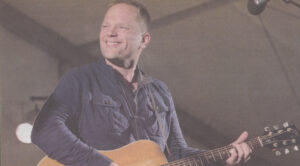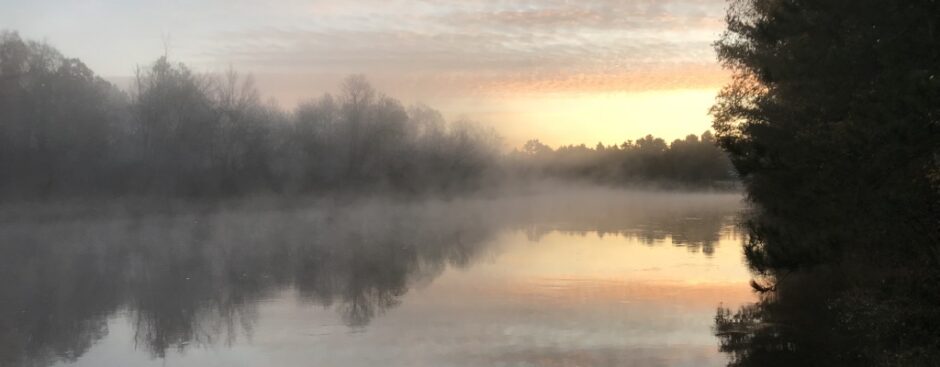
Mark Munger is a non-Finn with an interest in Finnish Americans.
MM:
What’s your ethnic and personal connection to the Finnish American story?
JR: I’m Finnish on both sides. My Mom’s line is from the Kuortane area. My Dad’s line is from the Vaasa area. Both sides were Swedish-speaking Finns, which is why my last name is Rundman. My Great-Grandparents came to Ishpeming from Finland. My Dad was a teacher and taught briefly in Hancock. That’s where I was born in 1971. My parents then returned to Ishpeming where I grew up. I’ve been wondering if my birth in Hancock (the hospital is now part of Finlandia University) connected me to the history of the Suomi Synod.
My grandparents spoke Finnish and/or Swedish but didn’t teach my parents those languages. In the ‘40s the trend was “We’re Americans so speak English,” though I heard Finnish around me, and my home church had Finnish language services.
MM:
As a child, were you steeped in Finnish history and culture?
JR: Finnish identity is part of my family narrative. My cousins and I grew up valuing it highly. My relatives had saunas and we enjoyed Finnish coffee bread, and Nordic artwork and home furnishings. In the late-90s I connected to cousins in Finland, and they sent me Finnish folk and pop music CDs. My wife and I visited Finland in 2001 and return every five years or so.
MM:
How did you become a touring musician?
JR: As a teenager I dreamed of being a musician. In high school, I had paying gigs playing folk/rock music and Lutheran church music. I graduated at seventeen but instead of attending college, I hit the road playing music. My career started in the late-80s, just as CDs became popular. Then, as the internet emerged, advances in technology allowed independent artists like me to build national touring careers. Playing on NPR’s Mountain Stage was a highlight! The show is taped in West Virginia, but occasionally they take the show on the road. They scheduled a taping in Minnesota and wanted to feature regional musicians. Producer Larry Groce was familiar with my album Public Library, so I was thrilled to be invited to perform, especially since as a teenager, I was a huge fan of The BoDeans from Milwaukee, the headliners on the show!
MM:
Were any of your immediate family musicians?
JR: I have aunts on both sides who were church organists. Music was a huge part of my childhood. I took piano lessons, immersed myself in the Top 40 hits, and drew inspiration from MTV. I started writing songs, inspired by Paul Simon and folk-flavored rock bands like the Rainmakers, the Silos, John Mellencamp, and the Hooters.
MM:
Was there an evolution of your music where your Finnishness became part of your writing, singing, and performing?
JR: The first time I played Finnish music was 1989. I was part of a band performing Pekka Simojoki’s Finnish African Gospel Mass. I included a selection from this liturgy “The Prayer of the Church” in my new book. In 2000, I released an album—Sound Theology—featuring my arrangement of a Finnish hymn called “Arise, My Soul, Arise.” That song also appears in the new book. I got caught up in a whirlwind of activity, playing Finnish fiddle music with Kaivama and Arto Järvelä. I didn’t know anything about the pelimanni tradition. It was a bit overwhelming to be thrown into touring in a new genre. But it was great fun and I continue to play Finnish folk music in my concerts. I have two teenaged kids who are excellent fiddlers. I’m proud to pass down the tradition to a new generation.
MM:
Talk about the transition from touring musician to seminary student.
JR: I’ve always been an active Lutheran, but never thought I’d become a pastor, because I was into my musical career and had no college degree. I was the guest musician for an event at Pacific Lutheran Theological Seminary in Berkeley, CA. While there, Rev. Dr. Kirsi Stjerna sat me down and said, “I think you should go to seminary.” No one had ever said anything like that to me. I replied, “Thank you, but I can’t because I didn’t go to college.” Kirsi replied, “There are now pathways for non-traditional students like you to go to seminary.” She gave me suggestions of people to call. I entered candidacy in the ELCA, was accepted to Luther Seminary, given a full scholarship, and in 2018 became a student! After 30 years as a touring musician, I was pleased to be home with my wife and kids. I’ve enjoyed the challenges of the academic life. I’ll graduate in 2022 and be available to take a call as an ELCA pastor. That next chapter will be an adventure!
MM:
You’ve been working on the book you mentioned, Lost Songs of the Suomi Synod?
JR: Research began while performing at Nordic events where people shared Suomi Synod material with me. I also explored archives at Finlandia’s Finnish Heritage Center. Whenever a new hymnal is published, the previous edition becomes obsolete. Songs get lost and are never sung again. Where a song hadn’t appeared in English, I translated it. For example, I based my translation of “Pium Paum” on English interpretations, the Finnish original, and the Kalevala. For “Psalm 100” and “Psalm 150” I used my seminary skills to translate from the Hebrew and then Finnicized the images. Elias Lönnrot, the collector of the Kalevala, first brought Martin Luther’s German hymn “Holy Spirit We Pray” to Finland in the 1800s, and “rebuilt” it on a Finnish folk tune. I had great fun taking Lönnrot’s structure and crafting it into English. Hymns are metrical and mathematical, so it was a challenge to take images and ideas from Finnish and adjust them into English.
MM:
Let the readers in on the process used in creating new music for the book that fits in with original Suomi Synod hymns.
JR: It was important to let people know that hymnody is a living tradition. This is not historic preservation, like a Civil War reenactment or a Beatles tribute band. Music is always evolving. Finns love music and Finnish composers continue to create inspiring work. I included my own material, some which also appears in All Creation Sings (published by Augsburg Fortress). I’m pleased to continue the legacy of Lönnrot, Runeberg, and Sibelius. I would love it if Finnish-Americans could send new music back to Finland!
MM:
What parameters went into curating music that’s included in the book?
JR: A few Nordic hymns are beloved … such as Sibelius’ FINLANDIA (often sung as “This Is My Song” or “Be Still My Soul”), and classics like “Children of the Heavenly Father,” and “How Great Thou Art.” I didn’t include these because they’re not “lost”.
MM:
Describe the editorial choice to include synod and musical history in the book.
JR: I read dozens of books and articles. I found no clear, concise Suomi Synod timeline or history of Lutheran hymnals. Most of the published material dates is from the 1960s (or earlier) and is out-of-print. I hope my book is an accessible resource, not only for musicians, but for historians.
MM:
Are you performing?
JR: When I started seminary, I decided to retire from showbiz. I knew it’d take all my brainpower to finish my schooling. As COVID restrictions loosened, I was offered opportunities, so I’ve been touring with Walter Salas-Humara of The Silos and working on his new recordings. I’m also recording songs from the book to be released via streaming services. My debut single is a new arrangement of Runeberg’s “Paavo the Peasant”. People can listen to it on Spotify, Apple Music, and YouTube. Coming up, there’s a book-release concert at Luther Seminary in St. Paul on September 21 at 7:00pm (free and open to the public). I’ll be a part of Finlandia University’s 125th Anniversary Celebration in December. I’ll be performing at the Luther500 Festival next summer in Wittenberg, Germany. Folks can also book me for their town, church, or Finnish heritage event to hear songs that haven’t been heard in North America for a century!
MM:
With the book being released on September 7th where can folks find it?
JR: Amazon will have it, but the best way to get it is to order directly from me at www.jonathanrundman.com. Folks can also email me at rundman@gmail.com.
Kiitos, Jonathan! Readers can find out more at:
https://finland.fi/arts-culture/american-finns-stretch-music-traditions/ and
https://www.mprnews.org/story/2013/01/02/kaivama-lighting-dark-winters-with-finnish-folk-music.


